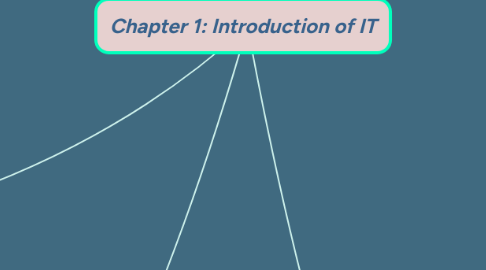
1. Definition
1.1. The use of computer software and hardware to retrieve,manipulate and store information for future use
2. Categories
2.1. Supercomputer:
2.1.1. Fastest and most powerful computer. Capable to process more than one quadrillion instruction in asingle second
2.2. Mainframe:
2.2.1. Large, expensive, powerfull computer that can handle hundreds or thousands of connected user simultaneously
2.3. Pesonal computer
2.3.1. A computer can perform all of its input, processing, output and storage activity by itself
2.4. Mobile computer and Devices:
2.4.1. Mobile computer: Personal computer you can carry from place to place such as laptop computer and tablet pc
2.4.2. Mobile device: Computing device small enough to hold in your hand such as smart phones, digital cameras and portable media players
2.5. Embedded computer:
2.5.1. Special purpose computer that is function as a component in a larger product such as anti lock brakes, airbag controller, printers
3. Characteristic of computer
3.1. Supercomputer
3.1.1. Physical size:
3.1.1.1. Occupy a full room of equipment
3.1.2. Speed:
3.1.2.1. Tens of thousands of processors
3.1.3. Storage (referring to memory):
3.1.3.1. Extremely large storage
3.2. Mainframe
3.2.1. Physical size:
3.2.1.1. Occupy partial room of a full room of equipment
3.2.2. Speed:
3.2.2.1. Dozens of processors
3.2.3. Storage (referring to memory):
3.2.3.1. very large and addable storage
3.3. Personal computer
3.3.1. Physical size:
3.3.1.1. Fits on a desk
3.3.2. Speed:
3.3.2.1. Single processor
3.3.3. Storage (referring to memory)
3.3.3.1. Large
3.4. Mobile Computers:
3.4.1. Physical size
3.4.1.1. FIts onyour lap or in your hand
3.5. Mobile Devices:
3.5.1. Physical size:
3.5.1.1. Fits in the palm of your hand or a pocket size
3.6. Embedded Computers
3.6.1. Physical size:
3.6.1.1. Miniature. It is mounted on a circuit board
4. Advantages
4.1. Communication
4.1.1. People all around the world can communicate each other easily
4.2. Speed
4.2.1. Student can search many information in a single second
4.3. Storage:
4.3.1. Computer can be use to store large amount of data and information
4.4. Reliability
4.4.1. The electronic components in computer are dependable and reliable because they rarely to break
5. Disadvantages
5.1. Health risk
5.1.1. When we use computer for a long time it can effect our eyes and cause eye iritation
5.2. Waste time:
5.2.1. Spend to much timefor not important thing
5.3. Public safety:
5.3.1. We might be a victim to crime if we are exposing or sharing out photos, videos or other personal information publicly
5.4. Violation of privacy:
5.4.1. Other person might steal our personal and confidential records if they were not protected properly
5.5. Impact on labour force:
5.5.1. Mnay employee might jobless if their skills have been replaced by computer
6. Application
6.1. Education
6.1.1. Learning Management System- Student can get their lecture note, answer quizzez and submit assignment by using learning management system
6.1.2. Computer Based Training- uses computer: uses computer-generated visuals or environment for training such as fligth simulator used by pilots before flying new plane or different types of plane
6.2. Finance
6.2.1. Finance Investment System- inventories buy and sell stock and bon online without using broker
6.2.2. Online banking- to pay bills, track personal income and expense, manage investments and evaluate financial plans
6.3. Government
6.3.1. E-filing- online system for declaring tax
6.3.2. E-Syariah- online portal for providing information about the rules and procedure of the court
6.3.3. HRMIS-online system for updating government employee information
6.4. Health care
6.4.1. Medline- many web sites provide up-to-date medical fitness, nutrition or exercise information
6.4.2. Counter Registration System- hospitals and doctors use computers and mobile devices to maintain and access patient record
6.4.3. Telemedicine- health care professionals in seperate locations conduct live conference in the computer
6.4.4. Telesurgery- surgeon performs an operation on a patient who is not located in the same physical room as the surgeon
6.5. Science
6.5.1. Virtual reality- use of computer to simulate a real or imagined environment that appears as 3D spaces
6.5.2. Cochlear implant- use of computer technology to help user in hearing problem
6.5.3. Hawk Eye Officiating System- complex computer targeting system that is used to track the path of an object is being developed for use in sports such as tenis and football
6.5.4. Neural network- a system that attempt to imitate the behaviour of human brain
6.6. Publishing
6.6.1. Online Newspaper & Online Magazine- allow user to get information easily by reading newspaper and magazine online
6.7. Travel
6.7.1. Global Positioning System (GPS)- IT application that helps users to track routes for specific location
6.7.2. Online Reservation System- transportation and accomodation reservation can be done through website
6.7.3. E-ticketing- online booing ticket
6.8. Manufacturing
6.8.1. Computer-Aided Design- use of computer systems to increase designer productivity and design quality
6.8.2. Computer Aided Manufacturing- controls machine tools, mainly robot arms, in high tech assembly line. It used to speed up and improve accuracy of the process for task

